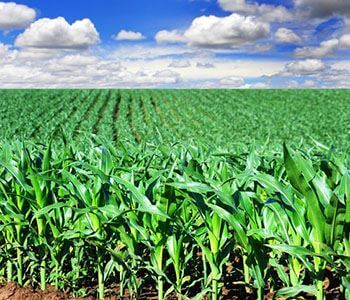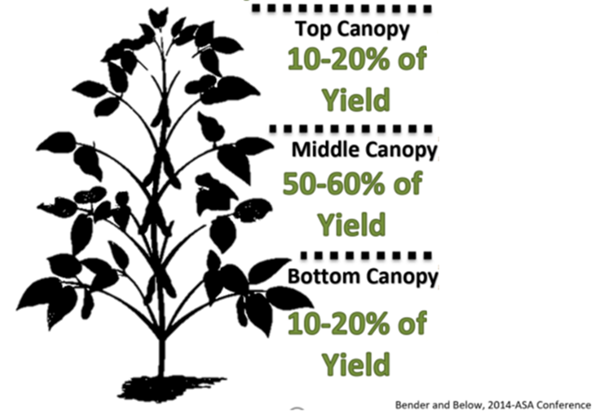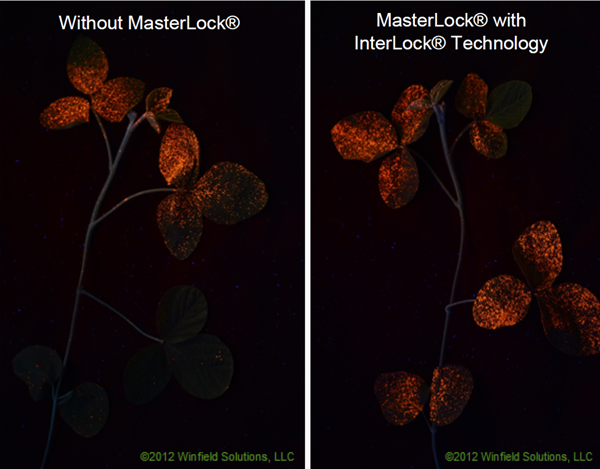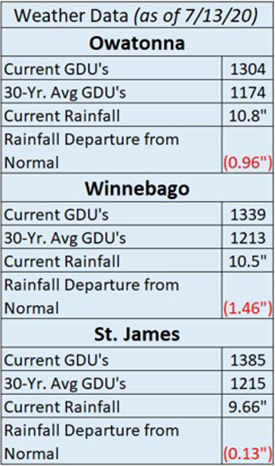2020.07.15 Growing Insights
Jul 15, 2020

|
|||||||
| Soybean Fungicide Agronomy | |
| Pod set through seed fill stages (R3 through R6) are the most critical period for yield potential in soybeans! Fungicides help protect soybeans from fungal disease pressure, as well as keeping the trifoliate’s photosynthesizing efficiently. Common soybean foliar diseases like Septoria Brown Spot or Frogeye Leaf Spot infections typically occur during warm, moist weather. Infection typically occurs when plant leaf wetness, from rain or dew, exceed 12 hours per day. Ross Bender and Fred Below (University of Illinois) report through their research that the middle 7 nodes of a soybean plant constitute between 50% - 60% of soybean yield. Supplemental fertility increases yield in the middle and top canopy. The number of beans per pod increases from bottom to top of the canopy, most likely resulting in a greater light interception. Fertilization improves pod set and seed weight in the bottom and middle. Foliar protection lengthens effective filling period, increases seed weight, and mostly benefits top nodes, which improves yield. Each soybean plant often has 12-20 nodes on the main stem, 1-3 clusters of flowers at each node, 6-12 flowers per cluster, and 72-720 flowers per main stem. Even with such high amounts of potential pod sites, 65-75% of the flowers and pods are aborted because soybeans have to live day-to-day. They don’t have a big stalk or leaves like corn to store nutrients in, so they rely on daily nutrition provided by photosynthesis. The name of the game in-season is to keep the plant healthy and the leaves photosynthesizing and reduce the amount of “bad days” the soybean plant endures. Each trifoliate help feed a cluster of flowers and pods at each node. Just getting 1 more pod/plant to convert to a 3-bean pod is equal to almost 3 bushels! That’s why it’s critical to protect soybean trifoliates that act as a “solar panel” to feed the flowering nodes and pods. |
|
|
|
 |
| Soybean Fungicide Results | |
| The AnswerPlot system evaluated soybean fungicide response in 2019. Ten different fungicide treatments were made on two different varieties which were replicated three time for a total of 60 different plots in a location near LeSueur. Some downy mildew and frogeye leaf spot popped up at about R5, but the plots had low disease incidence. An early reproductive stage fungicide application yielded a 3.84 bpa average advantage vs. untreated trials. Keep in mind that this is a single location trial, which may increase the chances of environmental/other issues playing a role in the results. All fungicide applications in this trial were made using MasterLock in order to assist with canopy deposition and coverage. As seen in the pictures below, MasterLock sprayed on soybeans in combination with fluorescent dye was able to provide better coverage on trifoliates that were found in the mid-to-low canopy. Contact your local CFS representative on 2019 soybean fungicide responses and which product makes the most sense for your acres in 2020!
|
|
|
|
 |
| Corn Reproductive Stages |
| Emerging tassels signal the beginning of the corn plant switching from vegetative to reproductive growth. On average, it takes about 55-60 days between from VT/R1 to get to physiological maturity (32-33% moisture). With all of the variables in the 2020 growing season final corn yield, tipback, and abnormal pollination will often tell the story of the weather and stresses the crop experiences over the next 55-60 days. Iowa State University ICM article offers these thoughts important insights to consider on how stresses affect corn yield in the reproductive stage: R1 or the silking stage: The silk is visible outside the husk and pollination occurs when pollen grains fall on silks. Under normal conditions, silks will grow 1-1.5 inches each day until fertilized. R2 or the blister stage occurs about 10-14 days after silking. The kernel is visible and resembles a blister on the cob at this stage. The kernel is filled now with clear fluid. If you dissect the kernel you will be able to see an embryo, this is the portion that sprouts the next year when the seed is planted. The kernels are approximately at 85% moisture content and this will decrease as they near maturity. If severe stress occurs now or during R3, kernels may be aborted from the tip-down to lessen the load on the plant. R3 or the milk stage will occur approximately 18-22 days after silking. The kernel is now yellow on the outside with the inside containing milky white fluid. Starch is rapidly accumulating in the kernel. By R3 cell division in the endosperm is complete and kernel growth that occurs now is due to cell expansion and starch-fill in the individual kernels. R4 or the dough stage will occur approximately 24-28 days after silking. The interior of the kernel has now thickened to a dough or paste-like substance. The kernels have now accumulated about half of their mature dry weight. Stresses will not likely cause kernel abortion by this stage. Prior to R5 the kernels at the tip of the ear will begin to dent (beginning dent). R5 or the dent stage will occur approximately 35-42 days after silking. Kernels are dented in at the top and are drying down. Kernels have 55% moisture content at the beginning of R5. You will be able to see a line separating yellow from white on the kernel; this will progress downward as the kernel matures and the starch hardens. Stress is only able to reduce kernel weight at this time by hindering dry matter accumulation. R6 or physiological maturity occurs approximately 55-60 days after silking. All kernels have reached their maximum dry matter accumulation now since the starch layer has moved completely to the cob. A black or brown layer will be visible at the base of each kernel. Tip kernels will first reach this black layer stage followed by basal kernels. Kernel moisture is now between 32-33% with much variability due to hybrid and environment. Moisture moves out of the kernel easily if the plant is still green. Stress that occurs now will have little effect on yield except if plant lodging or insect feeding on the ear occurs. |

